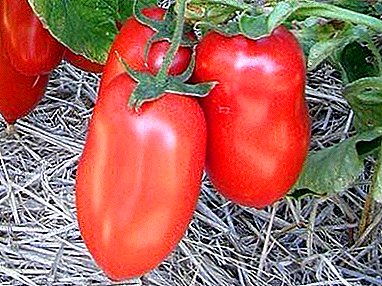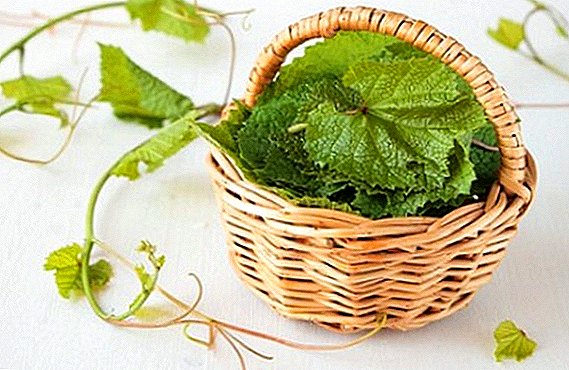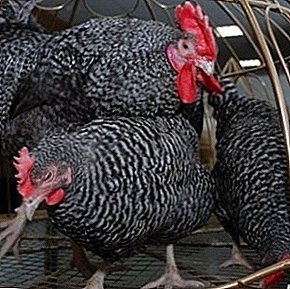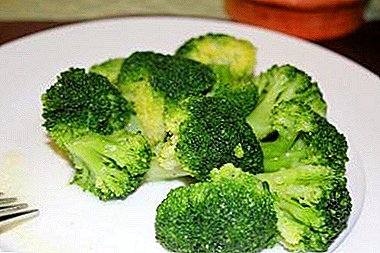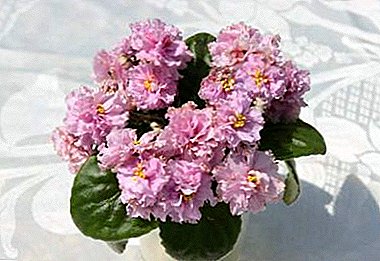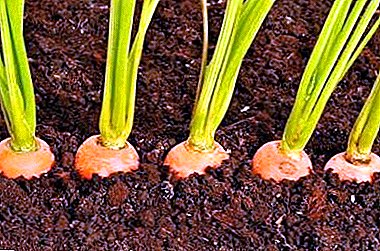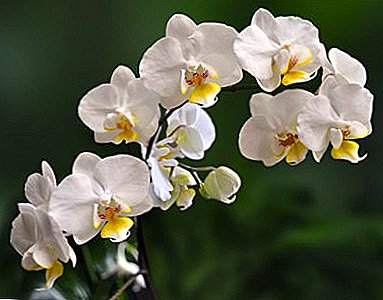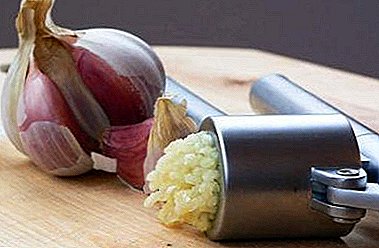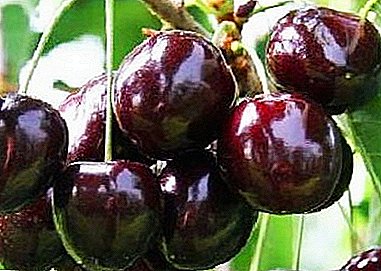
Amateur gardeners are less likely to plant cherry trees on their summer cottages, preferring the cherries because of their unpretentiousness and presentation.
Recently, however, more than 150 new, interesting and productive varieties of cherries have appeared. One of these varieties is Black large.
It has a lot of merit worthy of attention and a small number of drawbacks and is well suited for growing in its own courtyard. Cherry variety Black Large - one of the most large-fruited, with excellent taste, the description of the variety is further in the article.
Breeding history and breeding region
 This remarkable variety was obtained as a result of crossing medium-early cherry varieties. Zhukovskaya and Consumer black.
This remarkable variety was obtained as a result of crossing medium-early cherry varieties. Zhukovskaya and Consumer black.
The plant breeder of the Rossoshanskaya gardening station, A. Ya. Voronchikhin, was engaged in breeding it.
In 2000, the Black Large was zoned according to North Caucasus region of the Russian Federation. It is also widespread in Volgograd, Voronezh, Rostov and Belgorod regions. At least a variety of cherries Black Large can be found in Belarus and Ukraine.
Such varieties as Vavilov Memorial, Novella, Nadezhda and Morozovka also feel excellent in these areas.
The appearance of cherry Black large
Consider separately the appearance of the fruit tree and its fruits.
Tree
Black Large low, about 3-4 m, with a thick spreading pyramidal crown. The bark is gray, dark, slightly rough, not cracking. The shoots are long, medium thickness, straight, with large internodes.
Bark on young shoots is greenish, with age it becomes grayish-brown, with silver patina. Lentils not pubescent, reddish, rarely located.
Kidney rather large, oval, with a sharp tip, not adjacent to the shoots.
 Leaves large, long, oval in shape, with a sharp top, dark green, glossy, with very small teeth at the edges, without stipules.
Leaves large, long, oval in shape, with a sharp top, dark green, glossy, with very small teeth at the edges, without stipules.
The scape is thick, long, not pubescent.
Flowers quite large, grow by 3, sometimes 2 pieces per inflorescence. Petals are wide, white, darker by the end of flowering.
Fruit
Berries of this variety very large, weighing 5-7 grams, roundish, strongly flattened from the sides, not prone to shedding. The skin is thin, very dark, almost black.
The flesh is tender and juicy, dark red, sweet with a barely noticeable sourness, very sweet dessert taste. The stone is small, well separated.
This variety is not pollinated on its own, so be sure to plant alongside such varieties as: Spectacular, Kent, Turgenevka, Griot Ostheims, Zhukovskaya, Rossoshanskaya black.
A photo





Characteristics of a variety
The main advantages of the varieties Black large include early onset of fruiting. The first harvest can be collected already 3-4 years after landing.
Black Big Cherry is medium early variety with a late flowering period.
 The variety of Cherries Black Large has a good yield and precocity. From one young 6-8-year-old tree can be collected about 15-25 kg of berries.
The variety of Cherries Black Large has a good yield and precocity. From one young 6-8-year-old tree can be collected about 15-25 kg of berries.
The high yields are also demonstrated by the Uralskaya Rubinovaya, Pamyati Yenikeeva, Turgenevka, Podbelskaya.
However, the trees of the Black Major are short-lived, about 15-17 years oldand with age it is characteristic of them sharp decline in yield.
The frost resistance of the variety is quite high. Maintains a drop in t to -32-34С without any special damage to fruit buds.
Generous, Chocolate Girl, Shubinka and Vladimirskaya will also please you with good snake resistance.
Black large - all-purpose cherry variety. It perfectly is suitable both for processing, and for the fresh use. Can be stored about 1-2 months in the fridge. Suitable for quick freezing.
One of the major shortcomings of the Black Large variety is instability to mushroom diseases. Very often, especially in wet and cold weather, it is affected moniliozom, a little less - coccomycosis.
Planting and care
Despite the relative winter hardiness, it is better to land the Black large at well lit, warm and protected from northern winds place.
Planting is carried out only in spring, before bud break.
 For this variety is well suited light sandy or loamy soil. Prepare it in advance: shallow digging and lime.
For this variety is well suited light sandy or loamy soil. Prepare it in advance: shallow digging and lime.
A week after that, organic fertilizers are applied, approximately 10-15 kg of compost or humus per 1 sq. M.
Near necessarily have to plant at least 3 different pollinator varieties. Landing scheme: 2.5 * 2 m.Landing holes are prepared in the fall. They should be 50-60 cm deep and about 100 cm wide. In the center necessarily strengthen a peg for a garter of a sapling.
In the pit is placed a mixture of top soil, 10-15 kg of humus, 0.4 kg of superphosphate and 0.5 kg of ash and placed the tree.
When planting should be monitored to root neck was located 6-7 cm above ground level. Landing place carefully bury and tamped.
Around the seedling make a deep enough hole for watering. Then into it 10-15 liters of water are poured in and mixed with dry compost. Seedling loosely tied to a peg "eight".
In the first 2-3 years of life tree care will be in timely watering, weeding and loosening the soil. After watering wet ground be sure to mulch with a thick layer of peat or dry humus.
 Loosen the soil at least 3 times per season, to a depth of about 7-8 cm, so as not to damage the roots of the plant.
Loosen the soil at least 3 times per season, to a depth of about 7-8 cm, so as not to damage the roots of the plant.
Fertilizers begin when the tree begins to bear the first fruits.
Compost or humus contribute no more than once every 2 yearsand mineral fertilizers - Twice a year.
In the autumn, under the digging, add well phosphorus and potassium, and in the spring - nitrogen. Once in 5 years the soil is additionally lime dolomite flour or ash.
Fruiting trees are watered once per season, during the ripening of berries, 2-3 buckets of water per plant. Young trees - more often. Dry and hot weather cherry watered 2-3 times a month.
Immediately after planting the seedlings spend the first pruning. About 7-8 of the strongest and thickest branches of which the crown will be formed are left on the tree.
Pruning of trees should be carried out in the spring, a month before the buds begin to swell. The Black Large variety does not tolerate a strong crown thickening, therefore all branches, with shoots over 40 cm, must be shortened.
Also remove all the branches that grow inside the crown. In an adult tree should remain no more than 10 major skeletal branches.
With proper care and compliance with the rules of pruning, you can significantly reduce the risk of the incidence of tree moniliosis.
Diseases and pests
 A significant disadvantage of Black Big Cherry is its tendency to be affected by such unpleasant fungal diseases as coccomicosis and moniliasis.
A significant disadvantage of Black Big Cherry is its tendency to be affected by such unpleasant fungal diseases as coccomicosis and moniliasis.
Suffering from coccomicosis mainly leaves, less often - berries.
The first signs of his appearance are small brown dots on the upper side of the sheet.
Later dots grow, and the lower part of the leaves is covered with a pinkish bloom. Diseased leaves dry quickly and fall off. The affected berries are severely deformed and turn black.
To get rid of coccomicosis, the affected branches are removed and the sections are treated with a mixture of copper and iron sulphate. All fallen leaves are removed and burned. At least 2 times per season, wood is treated with a 3% Bordeaux mixture.
The varieties Fairy, Tamaris, Tsarevna and Ashinskaya are resistant to coccomycosis.
A much greater danger to cherries is monilioz The whole plant suffers from it: leaves, shoots, branches and berries. Best of all, this disease develops in cold and damp weather.
The first leaves are affected: small brown spots appear on them, which grow, they become like extensive burns. Then the disease moves to the trunk and shoots, later - to the berries. If time does not begin treatment, the tree may die.
To combat moniliosis, spraying with Bordeaux mixture or copper sulfate is used.
 It is imperative to remove all diseased parts of the plant, remove fallen leaves, cut off the affected bark from the trunk and immediately burn it all.
It is imperative to remove all diseased parts of the plant, remove fallen leaves, cut off the affected bark from the trunk and immediately burn it all.
Cherry Black Large is less common in young plantings. And in industrial cultivation it is almost not used at all.
The main advantages of the variety include:
- small size of the tree;
- early onset of fruiting;
- very beautiful large berries, with excellent sweet taste.
Among the shortcomings can be identified:
- short life of the tree;
- propensity to defeat coccomycosis and moniliasis.
But with good care, timely processing and proper pruning, the risk of disease can be significantly reduced, and then a large Black Cherry will decorate any garden plot.



